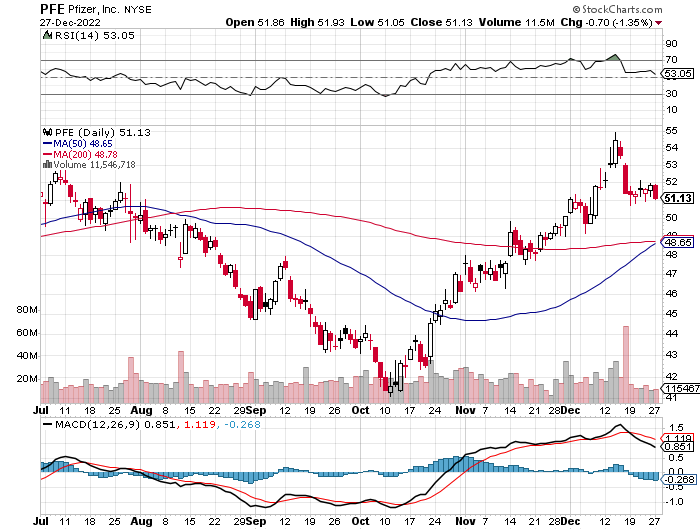As we brace ourselves for another uncertain year, large-cap biotechnology and healthcare companies continue to be viewed as attractive options for a defensive play. These businesses offer a chance at insulating some capital from the slippery slope many investors still anticipate in 2023.
That perspective boosted the stock prices of several names in the healthcare industry in 2022. Some of the biggest companies in this sector are up, including UnitedHealth (UNH), Eli Lilly (LLY), and Johnson & Johnson (JNJ). In fact, the Health Care Select Sector SDPR fund (XLV) is only down by 4.6% compared to the S&P 500, which slid by roughly 20%.
With 2022 coming to a close, it’s reasonable to expect the trend to continue next year. Looking at the industry, there are still many names with a lot of room to grow.
One of them is Pfizer (PFE).
Given its performance and plans, Pfizer stands out as one of the best risk-adjusted options to own in this sector. Actually, this stock could give the likes of AbbVie (ABBV) and Bristol-Myers Squibb (BMY) a run for their money.
While its minimal gains have not kept pace with other Big Pharma names, Pfizer still easily bested the -14% recorded by the S&P 500. This is because investors remain anxious over the company’s future post-COVID. However, Pfizer has aggressively developed its pipeline and leveraged its COVID-19 profits to create more blockbusters.
One promising project is its migraine franchise, which Pfizer received following its $11.6 billion acquisition of Biohaven. The company estimates $6 billion in peak sales yearly from this program.
Another asset that Pfizer added via acquisitions is ulcerative colitis treatment etrasimod, which the company received following its $6.7 billion deal with Arena Pharmaceuticals. Given the decent-sized market for this condition, the candidate is expected to rake in $1 billion to $2 billion in peak sales.
Multiple myeloma treatment Elranatamab is projected to turn into a blockbuster as well. Although this market is already a bit crowded, with Legend Biotech (LEGN) and Johnson & Johnson leading the charge, Pfizer’s candidate can still attract its own share. So far, Elranatamab is projected to rake in $4 billion in peak sales.
The company is also leveraging its established reputation in the vaccine world. Pfizer’s vaccine candidate for the respiratory syncytial virus (RSV) is anticipated to become another blockbuster, with estimated annual sales to reach more than $2 billion.
Aside from these, there are 13 more candidates in the company’s pipeline. All these short-term catalysts are expected to deliver a compounded annual revenue growth rate of roughly 6% from 2020 up until 2025. Notably, this projection does not include the profits from its COVID-19 franchise.
Meanwhile, there are several longer-term catalysts queued in Pfizer’s R&D plans.
One is the expansion of its mRNA vaccine dominance, which is projected to become a $10 billion to $15 billion yearly business in the long run. While sales for its COVID-19 vaccines and boosters are expected to decline, the combination vaccine targeting the flu and COVID-19 could realistically be the primary driving force for this program. Even the shingles vaccine looks promising, with peak sales projected to reach $6 billion by 2030.
Its sickle cell disease program, which Pfizer received via its acquisition of Global Blood Therapeutics, is anticipated to rake in $3 billion in peak sales. If approved, this could go head-to-head against Vertex (VRTX) and CRISPR Therapeutics’ (CRSP) much-awaited candidate.
Overall, Pfizer is an excellent defensive player in this tumultuous period. Its resilience and ability to withstand recessions and bear markets are clearly top-notch. Its core business and pipeline look promising. Plus, despite its strong financial resources and incredible track record, its low valuation makes it an underrated stock with a value notably stronger than the average investor can appreciate.


